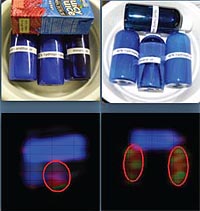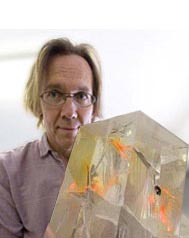About LANL
About Our Capabilities, Facilities, and Staff
"Los Alamos National Laboratory plays an indispensable role in building America as a science and technology powerhouse, and our staff are an incredible resource to the nation and the world." Michael Anastasio, Dir.
Solving Complex R&D Problems with Special Blend of Staff, Capabilities and Facilities
Now in its seventh decade, LANL remains among a very few laboratories that can bring great breadth of fundamental and discovery science, technology, and engineering rapidly together to create tangible solutions for national security needs.
Our staff, working with partners throughout science and industry, must be able to deliver today's solutions while maintaining the depth of capabilities to deliver the next generation of discoveries.
Los Alamos has demonstrated a cycle of innovation where we have developed world-leading capabilities and facilities in response to urgent, unique missions. We also spin out new discoveries that lead to emerging missions.
Being able to integrate and apply our capabilities rapidly to new challenges will be a key advantage in an increasingly competitive landscape.
Our Science, Technology and Engineering Priorities
Science that Matters
- Information science and technology enabling integrative and predictive science
- Experimental science focused on materials for the future
- Fundamental forensic science for nuclear, biological, and chemical threats
How We Work
- Collaborate, partner and team to make decisive contributions to our sponsors
- Outstanding operational excellence for safety, security, and efficient pursuit of ST&E for our missions
Transform Our Scientific Campus
- Campus for 2020 (consistent with complex transformation)
- Modern science facilities: LANSCE refurbishment, CMR replacement, Science Complex
- Signature facilities for experimental science (MaRIE) and computational science (Roadrunner)
More About This Science
Concealed Threats in Liquids
Ground-breaking MagViz device aids faster, accurate airport screening

Quick Read
MagViz distinguishes potential-threat liquids from harmless shampoos and sodas screened at airport baggage checkpoints.
Airports are stressful places—long lines, frequent delays and a frantic pace. MagViz, a scanning machine that differentiates dangerous substances from benign liquids and gels such as shampoo and beverages, could be the answer to safer, less stressful travel.
Los Alamos National Laboratory (LANL) scientists developed the technology, adapted from Magnetic Resonance Imaging (MRI) techniques but with far more capabilities.
MagViz is revolutionary not only because it helps travelers get to their destination on-time but because it identifies concealed threats that look harmless, such as bottled water or a tube of toothpaste. In fact, unlike MRIs, MagViz can even locate threats hidden inside the metal foil of a child's juice box. MRI machines are stumped by metal, so common baggage such as suitcases or laptop computers could not be screened.

When a threat chemical is identified, the machine marks the technician's image of the screened container with a red dot; harmless substances get green dots; a yellow dot indicates further inspection is required. Currently, MagViz identifies 50 liquids, with more threat-reduction capabilities coming soon.
"That's one of the beauties if this technology," LANL project leader Michelle Espy said. "We can add different threats as we become aware of them."
How it Works
Ultra-low-field nuclear MRI-based identification senses atomic frequencies—chemical fingerprints—that create images for technicians to quickly find threats.
In an MRI machine, magnetic fields cause hydrogen atoms to line up and spin in a substance. The atoms begin to wobble, falling out of rhythm. This wobbling of hydrogen atoms occurs in unique patterns for different chemicals, captured by sensors in an easy-to-read image.
To increase accuracy, the Los Alamos team incorporated a prepolarization field 100 times stronger than the magnet used to measure the spin. The technology relies on sophisticated detectors called superconducting quantum interference devices, or SQUIDs. Whereas a hospital MRI detects spin with a sensor akin to a radio antenna tuned to a specific set of frequencies, SQUIDs can pick up the oscillation of hydrogen or other atoms at any frequency.
Although the MagViz system is capable of producing complex three-dimensional images, baggage-screening agents quickly receive a simple but precise color-coded readout.
In an impressive example of the Lab's unparalleled in-house collaborative capabilities, members from many diverse fields (such as physics, engineering, computing, instrumentation and space systems) helped develop MagViz. The widespread collaboration led to innovative ideas that allow units to be extremely small, portable and inexpensive so they can be used by medics for quick battlefield diagnosis or developing-world hospitals that lack the funds or large facilities required for conventional MRI machines.
A prototype was unveiled at the Albuquerque International airport in December, where it will be tested prior to proposed launch at many airports in 2012. MagViz currently screens and analyzes contents in one minute. The goal is for MagViz to work in conjunction with X-ray machines and speed up transportation without risking reducing security. Airline passengers will soon be able to relax and worry less about on-board terrorism—and they can conveniently travel with liquids.

Seismic sounds
Eureka moment arrives with a loud, sharp crack
Paul Johnson finds himself caught up in a mystery—how sound waves from an earthquake can trigger new events at distances far beyond what seemed possible . . .
Currents, the Laboratory's monthly employee magazine, highlighting people in the workplace.







